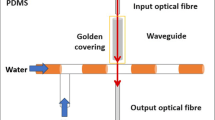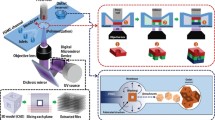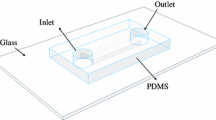Abstract
This paper presents a PDMS micro-optofluidic chip that allows a laser beam to be driven directly toward a two-phase flow stream in a micro-channel while at the same time automatically, detecting the slug’s passage and stirring the laser light, without the use of any external optical devices. When the laser beam interacts with the microfluidic flow, depending on the fluid in the channel and the laser angle of incidence, a different signal level is detected. So a continuous air–water segmented flow will generate a signal that switches between two values. The device consists of a T-junction, which generates the two-phase flow, and three optical fiber insertions, which drive the input laser beam toward a selected area of the micro-channel and detects the flow stream. Three micro-channel sections of different widths were considered: 130, 250, 420 μm and the performance of the models was obtained by comparing ray-tracing simulations. The master of the device has been realized by 3D printing technology and a protocol which realizes the PDMS chip is presented. The static and dynamic characterizations, considering both single flows and two-phase flows, were carried out, and in spite of the device’s design simplicity, the sensitivity of the system to capture changes in the segmented flows and to stir the laser light in different directions was fully confirmed. The experimental tests show the possibility of obtaining satisfactory results with channel diameters in the order of 200 μm.













Similar content being viewed by others
References
Baroud CN, De Saint Vincent MR, Delville JP (2007) An optical toolbox for control of droplet microfluidics. Lab Chip 7:1029–1033
Baroud CN, Delville JP, Gallaire F, Wunenburger R (2007) Thermo-capillary valve for droplet production and sorting. Phys Rev E 75:046302
Camou S, Fujita H, Fujii T (2003) PDMS 2D optical lens integrated with microfluidic channels: principle and characterization. Lab Chip 3:40–45
Chang-Yen DA, Eich RK, Gale BK (2005) A monolithic PDMS waveguide system fabricated using soft-lithography techniques. J Lightwave Technol 23:2088–2093
Chan HN, Chen Y, Shu Y, Chen Y, Tian Q, Wu H (2015) Direct, one step molding of 3D printed structures for convenient fabrication of truly 3D PDMS microfluidic chips. Microfluids Nanofluids 19:9–18
Hwanga Y, Paydarb OH, Candlera RN (2015) 3D printed molds for non-planar PDMS microfluidic channels. Sens Actuators A 226:137–142
Lapsley MI, Lin SS, Mao X, Huang TJ (2009) An in-plane, variable optical attenuator using a fluid-based tunable reflective interface. Appl Phys Lett 95:083507
Llobera A, Demming S, Wilke R, Buttgenbach S (2007) Multiple internal reflection poly(dimethylsiloxane) systems for optical sensing. Lab Chip 7:1560–1566
Llobera A, Wilke R, Buttgenbach S (2008) Enhancement of the response of poly(dimethylsiloxane) hollow prisms through air mirrors for absorbance-based sensing. Talanta 75:473–479
McDonald JC, Whitesides GM (2002) Poly(dimethylsiloxane) as a material for fabricating microfluidic devices. Acc Chem Res 35(7):491–499
Ng JM, Gitlin I, Stroock AD, Whitesides GM (2007) Components for integrated poly(dimethylsiloxane) microfluidic systems. Electrophoresis 23:3461–3473
Ono K, Kaneda S, Camou S, Fujii T (2003)Integration of multi-aspherical lenses and optical fibers onto a PDMS microfluidic device for fluorence-based detection. In: 7th International conference on miniaturized chemical and biochemical analysis systems, pp 1307–1310
Song W, Psaltis D (2011) Pneumaticcaly tunable optofluidic \(2\times 2\) switch for reconfigurable optical circuit. Lab Chip 11:2397–2402
Rossetto N, Ferrante C (2014) A microfluidic optical beam steerer. Microfluids Nanofluids 16:47–53
Sapuppo F, Bucolo M, Intaglietta M, Johnson PC, Fortuna L, Arena P (2007) An improved instrument for real-time measurement of blood velocity in microvessels. IEEE Trans Instrum Meas 56(6):2663–2671
Sapuppo F, Llobera A, Schembri F, Intaglietta M, Cadarso VJ, Bucolo M (2010) A polymeric micro-optical interface for flow monitoring in bio-microfluidics. Biomicrofluidics 4(1):1–13
Schembri F, Bucolo M (2011) Periodic input flow tuning nonlinear two-phase dynamics. Microfluidics Nanofluidics 11:189–197
Sapuppo F, Schembri F, Fortuna L, Llobera A, Bucolo M (2012) A polymeric micro-optical system for the spatial monitoring in two-phase microfluidics. Microfluidics Nanofluidics 12:165–174
Tabeling P (2005) Introduction to microfluidics. Oxford University Press, Oxford
Van Steijn V, Kreutzer MT, Kleijn CR (2007) PIV study of the formation of the segmented flow in microfluidic T-junction. Chem Eng Sci 62:7505–7514
Weber E, Keplinger F, Vellekoop MJ (2012) Detection of dissolved lactose employing an optofluidic micro-system. Diagnostics 2:97–106
Whitesides GM (2006) The origins and the future of microfluidics. Nature 442:368–373
Yeshaiahu F, Lee LP, Psaltis D, Yang C (2010) Optofluidics fundamentals, devices, and application. McGraw-Hill, New York
Acknowledgments
This work was partially supported by PON for the research project entitled HIPPOCRATES (PON 02_00355_2964193).
Author information
Authors and Affiliations
Corresponding author
Rights and permissions
About this article
Cite this article
Cairone, F., Gagliano, S., Carbone, D.C. et al. Micro-optofluidic switch realized by 3D printing technology. Microfluid Nanofluid 20, 61 (2016). https://doi.org/10.1007/s10404-016-1727-0
Received:
Accepted:
Published:
DOI: https://doi.org/10.1007/s10404-016-1727-0




